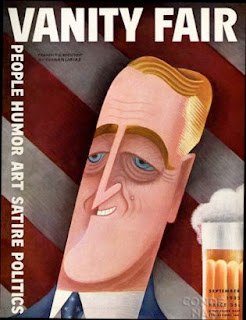 | |
| "Blood Over Manhattan" by George H. Rothacker acrylic on canvas - 24" x 30" |
Though articles on sports, politics and people were featured, the magazine focused primarily on the arts mixed in with a dose of satire and wit. As the effects from the depression spread across the populace, politics seemed to gain more visibility in the magazine, particularly on the magazine’s covers.
In the October 1931 edition, president Herbert Hoover became the first political figure “covered” on Vanity Fair. He was followed by Mahatma Ghandi in November, Britain’s prime minister Ramsey MacDonald in January 1932, New York Mayor Jimmy Walker in April of ’32 and Treasury Secretary Andrew Melon in May. Benito Mussolini and Adolph Hitler graced 1932’s October and November covers.
 |
| Caricature of NY Governor Franklin D. Roosevelt on the September 1932 cover of ‘Vanity Fair’, by Mexican artist Miguel Covarrubias |
Roosevelt won the 1932 election by a landslide, but the depression would continue throughout the decade with little economic relief . Lack of advertising revenue and changing times forced Conde Naste to fold the magazine into its sister publication, Vogue in 1936.
In 1983 Vanity Fair was reborn, once again blending art, politics, humor and satire to good effect. The covers however would never again be marked by the creativity, power and distinctiveness of those of the 1930s.
“Blood Over Manhattan,” George Rothacker’s painting of the newsstand built and operated by James Stratakos at the southwest corner of 32nd and Third Avenue, is in tribute to photographer Beatrice Abbott who recorded the scene in 1935. More than 200 magazines were sold at this location including Colliers, Photoplay, Modern Screen, Spectacular Detective, Redbook, Horse & Jockey and BallyHoo, as well as multitude of newspapers and tabloids.
